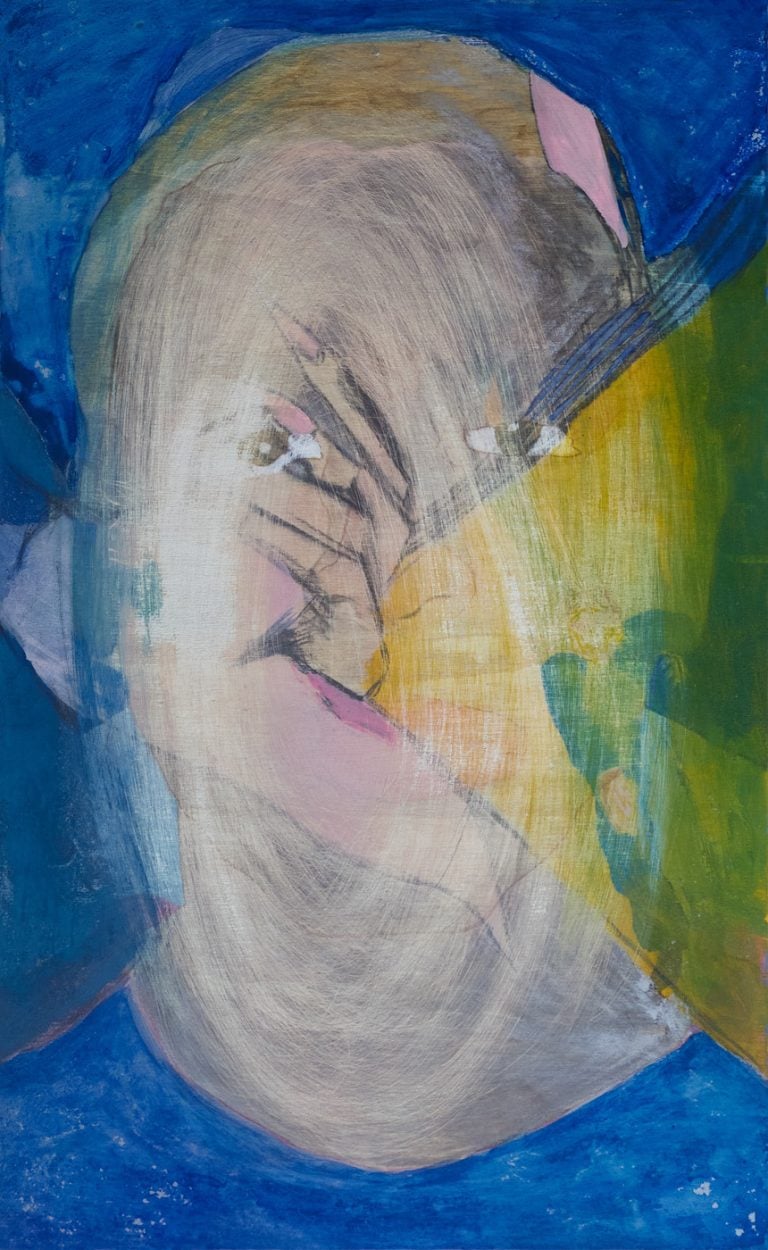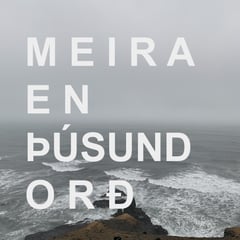“From one day to the next” – Pablo Jansana
For his presentation of new work at BERG Contemporary in August of 2023, Pablo Jansana betrays a fascination with an aperture that makes an existential change feel graspable. He does this by rendering transformation as both movement and proximity in relation to a portal, which beckons us to consider adjacent universes but does not guarantee safety. The portal opens unexpectedly between the known and the unknown, leaving a lingering suggestion of implicit violence. In Estrella distante, for example, four pairs of hands are depicted in various gestural poses around a pale grey oval that fades to a dusty blood red at its center. Two pairs at either extremity of the portal cup the phenomenon with their palms, as though either to conjure or to contain the passage. Two more pairs—laced with dark lines in a way that makes them appear skeletal—reach across the aperture longing for contact, despite the urgency of the vortex swirling below them on the painting’s surface. Between these hands, two dark red forms float; a pair of surgical sutures that bridge the yawning opening. Whatever the transformation in process in and around this oval void is, it is volatile, perhaps even monstrous.
Discursive associations flare up throughout my conversations with Jansana about this new body of work, for example Paul B. Preciado, a trans man, self-described feminist and queer philosopher based in France, and author of Can the Monster Speak? (Semiotexte, 2021). His slim volume reworks an address to a congress of Lacanian psychoanalysts in Paris in 2019 of a confrontational paper about heteronormative and patriarchal premises upon which—in Preciado’s view—psychoanalysis was founded. In it, he argued against a binary view of gender and in favor of a spectrum of identification that is radically in flux. Preciado’s experience of plural and volatile transformations in human subjectivity runs parallel to Jansana’s interest in the portal. “Imagine if we humans were that willing and able to transform, again and again,” the artist writes.
The same possibility frames the artist’s many layered references for this exhibition: What if we could fully metabolize the violence—such as heteronormativity; such as idealistic masculinity; such as authoritarianism—which we have been variously forced to endure, and become else through the passage beyond some volume in space/time?
The exhibition takes its title from the opening line of Myth of Pterygium (2022), Mexican author Diego Gerard Morrison’s debut novel, which reads: “From one day to the next, my right eye is bloodshot and itchy. Unusually so.” The central protagonist, Arthur, has awoken one morning in Mexico City with an ocular condition called a pterygium—a raised, fleshy growth that departs from the corner of the eye and, if allowed to grow, obstructs a person’s vision. This is case for Arthur, whose perception of several important transformations in his life becomes blurred, including the impending birth of his first child.
The eye out of which Arthur can barely see is figured as an oval portal in Jansana’s paintings. For Jansana, the novel speaks to the ambivalent nature of transformation. It represents the fact that change, which is integral to the human condition, is often both violent and hopeful. Arthur’s sudden loss of sight in the moment of change speaks to impending parenthood and the shifting priorities it forces on people, but Jansana also understood the novel as a statement about the nature of political transformation. In 2019, millions took to the streets in Chile demanding social and political change. The police targeted their rubber bullets at protestors’ eyes, leaving thousands half-blinded.
Many of the works that Jansana presents position the viewer inside a circular space of transition, one that resembles the ocular cavity, yet it is important to mark that like Arthur’s affliction, Jansana’s portals refuse the viewer cathartic resolution. The possibility to become otherwise is not a guarantee of stability. For example: on September 11th, 1973, General Augusto Pinochet led a military coup in Chile that would result in the suspension of civilian rule and all democratic political activity in that country. On September 11th, 2001 al-Qaeda coordinated four suicidal terrorist attacks on the Twin Towers in New York City, provoking a disastrous long-term US military response in Afghanistan and Iraq. Jansana’s paintings are not about either political event. Rather, they are addressed to the feeling of cognitive dissonance this kind of repetition produces in those who are close to both contexts. In Jansana’s case, he grew up under Pinochet and moved to New York in the decade of the Twin Towers attacks. The 9/11 he thought was a unique and irreparable transformation was experienced instead as a looping repetition.
In Jansana’s native Chile, where earthquakes are prevalent and of devastating force, people have turned to magical thinking to cope with the absurdity of large-scale catastrophic events that repeat. “Circularity is a difficult time and space to navigate,” the artist writes. “Magical realism helps to understand the feeling of mourning, that something is both close and yet so far away, that one is moving and also standing still.” Jansana’s new body of work is fundamentally concerned with narration, or how a story gets told, when this circular or looping aspect of the human experience is fully acknowledged.
In Offer for Communication (2023), a brick wall is distorted as two limbs emergence from its grid-like, rigid material regularity. The giant thighs rising to the foreground of the painting belong to a figure cut off at the waist. Where one might expect to find blood, muscle and bone, the space inside the forms is illuminated with a strange greenish-yellow light. I have the sense of standing above someone looking down at their own groin in stunned observation of an ongoing dimensional shift. Between these thighs, a dark greenish cloud is forming. A bright orange fin-like shape is growing out of the cloud and curling up against the brick background. Caught in the process of moving through a brick wall, I see a figure in the middle of birthing themselves and birthing a creature at the same time. Across the painting’s densely layered surface, human figures are drawn from observation in public space in Santiago and Copenhagen, alongside characters and symbols inspired by the work of Nancy Spero, Frida Kahlo, or Erna Rosenstein—all artists whose work depicts both pain and transformation.
The point of departure for Offer for Communication is the closing line of Myth of Pterygium, the moment in which Arthur becomes a father: ”From the deep ends of the room comes the disarming shrill of a new voice, shrieks of life and redemption. They’re appropriately angry, full of loathing, teeming with hope.” Jansana writes: ”The work is about this very dark place that transformation inevitably also is.”
An equally important conceptual reference for the body of work presented in “From one day to the next” is an experimental film by US-American artist Ellen Cantor (1962 – 2013), Pinochet Porn, which was begun in 2008 and finished posthumously by the artist’s friends and close collaborators in 2016. The film nominally follows the lives of five children raised during Pinochet’s military rule between 1973 and 1990. This is also roughly the period and context of Jansana’s own childhood; he was born in Santiago, Chile in 1976. According to writer and anthropologist Alkisti Efthymiou, the film speculates about “the construction of subjectivity and personal experience within a totalitarian regime,” or in a time and space that is suffused with both spectacularly public and intimate forms of violence. For Efthymiou as for Jansana, the film is a portrait of how people survive slow systemic violence or manage their own traumatization.
“At the same time,” Jansana writes, “I was reading and watching the play by Jean Genet, The Balcony.” Jean Genet (1910-1986) is an iconic French anarchist author and playwright, whose Encyclopedia Britannica entry introduces him as a “French criminal and social outcast turned writer who, as a novelist, transformed erotic and often obscene subject matter into a poetic vision of the universe…” marking several parallels to Ellen Cantor’s own vivid refusal of social norms and fascination with the abject. The Balcony unfolds in nine scenes, eight of which are set inside an eponymous brothel in an unnamed European city, which is in the throes of a revolutionary uprising. For Jansana, Genet’s play examines the ways in which political violence—physical force understood to be an extension of an ambition to rule—and violent domination in the context of interpersonal relationships bleed into one another. The half-blind thousands that marched in the street in 2019 will go on to live with half the world obscured. Sovereign force will shape their most intimate encounters for the rest of their days.
The works Jansana presents here are largely abstract, many with only the suggestion of an oval buried deep in their visual structure. My understanding of the body of work comes in part from a large and reassuringly figurative painting titled Self (2021) that I encountered in Jansana’s studio, but which is not included in the current exhibition. Nevertheless, Jansana marks it as the starting point for his work with the idea of the portal, and it is a key to the way notions of violence and hope saturate the work on view. In Self, a faceless figure with a large penis and an even larger open mouth squats in the concentric circles of a portal opening behind him/her/them, like a pebble resting on the surface of water in motion. One hand casually pulls back its lips to reveal immaculate teeth, which frame a second narrative space within the creature’s mouth. It is as though this figure is using its body to transmute the outer portal into a smaller and more stable one inside itself. Here a standing figure is visible from above. They are walking through a green sliver of landscape, fearless in the face of their potential transformation and with apparent disregard for the strange creature into whose mouth they have fallen. It represents the latent message of “From one day to the next” concerning the complexity of a fully human existence in a world of increasing struggle, but in which there remains the stubborn persistence of hope, both of which keep looping, moving, sucking us into the vortex of transformation.
Text by: Natasha Marie Llorens
About the artist:
Pablo Jansana (b. 1976, Chile) is a multi-disciplinary artist working with painting, sculpture and text. Jansana completed his BFA at Universidad Finis Terrae, Santiago, Chile before moving to New York in 2008, where he studied at the School of Visual Arts and and took part in the International Studio and Curatorial Program from 2009-2010.
Since 2019, the artist has been living and working in Copenhagen, Denmark. Jansana’s eclectic use of materials – including oil, watercolour, enamel, resin, wood and clay – feeds a continuous exploration of the space for reinterpretation, one that is located between images when accumulating, layering, erasing, or covering them up. Jansana is interested in materiality and how materials can themselves generate meaning, in juxtapositions of historical, personal, and fictive worlds, and in creating work that draws us into psycho-dramatic narratives and states of being.
The artist is represented in various public collections, including The Rema Hort Mann Foundation in New York, USA, Ministerio de Cultura y de las Artes, Chile, Museo de Arte Moderno Chiloe in Chile, Libreria Nacional and Museo de Arte Moderno Chiloe, Chile and CSAV, Santiago, Chile.










